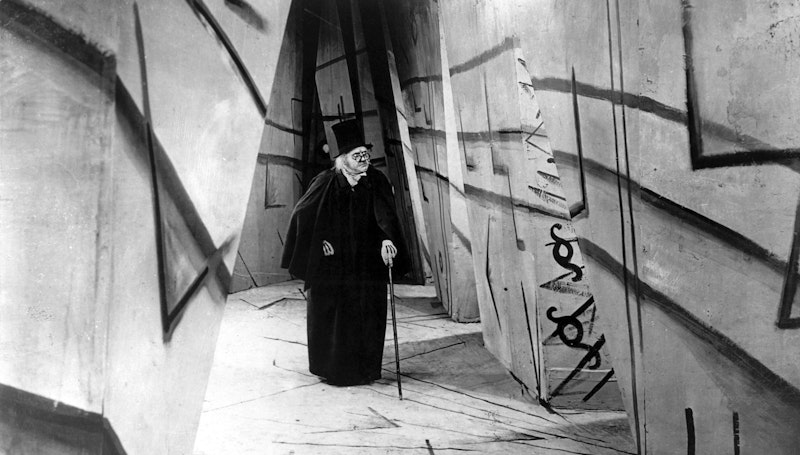Humans have difficulty admitting and accepting guilt. It’s easier being in a delusion of one’s own culpability and existence than admitting the problem of illusion. Illusions can be benign or poisonous. They can be lies we tell ourselves that may only harm us or lies that have a devastating effect on the society at large, creating a collective consciousness of moral corruption.
Robert Wiene’s The Cabinet of Dr. Caligari (1920) is a perfect representation of these elements. Not only is the film considered the beginning of what we know as the “Weimar Cinema,” it also deals with notions of madness, illusion, evil, and guilt—the very aspects that would later be realized in the horrors of World War II.
Conceived by Hans Janowitz and Carl Mayer, Caligari tells a story about Cesare (Conrad Veidt), a somnambulist, placed under the spell by the mad and grotesque man, Dr. Caligari (Werner Krauss). At first, Cesare is a curiosity and an exhibit at the town’s fair. Caligari convinces the audience that Cesare will do anything upon his command. This turns out to be true because Cesare becomes an unwilling murderer, terrorizing the town. Francis and his friend, Alan, visit the fair during which Alan’s informed by Cesare that he’ll die the next day. This turns out to be true. He’s murdered, and for a moment, Francis believes the Cesare’s “prophecy” has come true. But something’s not right.
Francis’ reason wins over the belief in magic and superstition, and he begins to investigate Dr. Caligari and his dutiful, hypnotized subject. He’s driven mostly by the need for justice and won’t stop until Caligari’s punished. But the journey from proof to actual judgment and punishment is a long one. First, he must convince the town that Caligari’s the guilty one. Cesare’s given a command to murder Francis’ fiancé, Jane, but at the last minute, something inside him changes. Instead, he carries her out of her quarters. Jane survives but, much like Hamlet’s Ophelia, she becomes mad from the encounter.
As the film unravels, Francis follows Caligari, who looks for a refuge in an insane asylum. As he enters, Francis frantically asks the asylum's doctors whether they have a patient by the name of Caligari. The doctors look at him quizzically but they offer Francis to meet with the director of the asylum, who can perhaps better assist him. However, it turns out that the asylum director is Dr. Caligari, who turned Cesare into a sleepwalking murderer.
As the end draws near, we learn that it’s Francis who’s a patient in the insane asylum, treated by a doctor who resembles Dr. Caligari. Krauss is now free of his grotesque Caligari makeup, but he retains the glasses. As the final scene comes, Caligari puts Francis into a straitjacket, and looks into the camera for the last time. Is Francis insane? Is Caligari who he claims to be? Has the entire film been an illusion?
Caligari is a claustrophobic, expressionistic nightmare. The setting’s incompatible with the human form. The rooms are elongated yet prison-like; town bureaucrats sit in disproportionally high chairs, signaling their supposedly lawful authority; Dr. Caligari moves like a portly man who’s both a nobody and an authority; and Cesare moves like a hypnotized, homicidal ballet dancer.
Janowitz and Mayer were influenced by their own experiences of World War I. Both men became pacifists when the war ended, and distrustful of authority. Dr. Caligari and his actions represent this, and Cesare’s just a hypnotized follower who kills for the thrill of it. It’s not his thrill but Caligari’s. Yet, Cesare still has some remnant of free will when he chooses not to kill Jane.
Nothing is as it seems in Caligari. There’s a constant illusion of existence in the film. Krauss’ face in the final scene doesn’t reveal anything definitive, and we’re forced into a dark, expressionistic corner, much like Francis. There’s no order, only nightmares that are lurking around the corner.
For the most part, the characters are under a spell, and this includes Dr. Caligari. Before he hypnotized Cesare and made him into a killing machine, Caligari was obsessed with becoming the evil master, and it appears that he too fell under some mystical spell of the faraway past.
It’s difficult to look at this film without any reference to National Socialism, despite the fact that it was made in 1920. Is Siegfried Kracauer correct to say that these anti-Semitic feelings were always there in the consciousness of the German people, waiting to be awakened? Did they masochistically accept obedience to authority?
It doesn’t help that Caligari’s main star, Werner Krauss, was a staunch Nazi, having a privileged place in the hierarchy of the party. During the Third Reich’s reign, Krauss starred in many anti-Semitic propaganda films, including Jud Süß (1940). Like most actors who were part of the propaganda regime, Krauss claimed innocence, stating that he was just an actor. Once again, poor and propagandistic aesthetics remained more significant than ethics.
Caligari can be evaluated through the historical lens but Wiene’s directions, as well as Janowitz and Mayer’s writing, is perennial. The film represents the illusions of life. An existence that’s built upon disorientation and temporary pleasures will result in a sleepwalking population. Anyone can become Dr. Caligari or Cesare but it’s far more difficult to become Francis. His concern for justice is admirable but it turns out not enough.
Whether he was originally just a patient in an insane asylum or if his story is true, Francis is swallowed by the insane masses, whose obedience to authority ultimately wins. In such a society, there’s no room for reason or justice, only acquiescence and passivity.

